Captain Larraq
Capitalist
Image Credit: Merkava Main Battle Tank (Real World)
Citations and Quotes: Where available, quotes and citations are designated with links to original source material.




Intent:To create a top tier Main Battle Tank that can fill a number of roles on the battlefield without sacrificing combat capability.
Production Information
Development Thread: The Myrker Campaign
Pre-Event: Invasion of Empress Teta
Pre-Event: Mining Ionite
Pre-Event: Heavenly Bodies
Pre-Event: Obligations to the Clan
Pre-Event: Bigger and Better; No Compensation Required
Post-Event: Mining Beskar
Post-Event: Forging Beskar / Hiring Beskar Smiths
Post-Event: Sundari Shotgun
Post-Event: Drive it Before you Buy it
Manufacturer: Mandal Hypernautics
Model: Myrkr-class Armored Vehicle – Assault “Myrkava”
Affiliation: Clan Dem'adas (Mandalorian), Mandal Hypernautics, Mandalorian Protectors, Mandalorian,
Modularity: Yes
Production: Mass
Material:
Durasteel Frame
Beskar-Tugsten Alloy Tracks and Wheels
Quadanium, Durasteel, Duraplast, Beskar, Tungsten, Polymer Composite Armor
Solid Beskar Main Cannon
Beskar-Glasteel Alloy viewslits
Technical Specifications
Role: Main Battle Tank
Squadron Size: 3 Tanks
Height: 3 meters
Width: 4 meters
Length: 8 meters (10m including gun barrel)
Weight: 85 Tons
Minimum Crew: 2; Driver, Gunner,
Optimal Crew: 4; Commander, Driver, Gunner, Loader,
Propulsion: Fuel Cell Engine
Top Speed: 65 KM/H on road, 55 KM/H off road
Operational Range: 1,000km
Passenger Capacity: 6 Seated Comfortably
Cargo Capacity: 2 tons miscellaneous equipment
Armaments:
140mm Smooth-bore Antimatter Reactive Cannon
20mm Coaxial Auto-cannon
40mm Remote Pintle Grenade Launcher
.52cal Remote Pintle Automatic Weapon
.32cal Remote Pintle Automatic Weapon
Payload:
x60 -140mm Shells
x336 -20mm Shells
x200 -40mm Grenades
x2,420 -.52cal Rounds
x2,500 -.32cal Rounds,
140mm Cannon Ammo Types:
6x HE, 6x AP, 6x HEAT, 6x HESH, 6x HE-FRAG,
20x Sabot Tungsten Rod, 10x Sabot Ionite Rod,
Misc. Equipment:
12x 60mm Internal Mortars (24x Sensor Disruption Grenades), ACS-403 EM Shielding, ACS-405 Enhanced Vehicle Sensor Suite, Optics, Infrared Optics, Ballistics Computer, Digital Fire-Control System, Target Identification Network, Cross-wind sensor, Electronic Sensors, Cabin Air Conditioning, Crew Cabin Intercom, Short Range Communicator (800m), Long Range Communicator (120,000m), Ground to Orbit Relay, Communication encryption systems, Electric Motor used in Turret and gun control system, Ballistic and Fire-retardant materials, 3x Ysalamiri in Beskar plated Nutrient Tubes (stored overhead in passenger compartment),
Weapon Ranges
Armor-Piercing Fin Stabilized Discarding Sabot: 19,200 meters (12 miles)
140mm Cannon Stationary Maximum Effective Range: 12,000 meters (7.5 miles)
140mm Cannon Mobile Maximum Effective Range: 8,000 meters (5 miles)
20mm Autocannon Stationary Maximum Effective Range: 6,400 meters (4 miles)
20mm Autocannon Mobile Maximum Effective Range: 4,800 meters (3 miles)
.32 Caliber Weapon Maximum Range: 3,200 meters (2 miles)
.52 Caliber Weapon Maximum Range: 2,000 meters (1.25 miles)
40mm Grenade Launcher Maximum Range: 1,400 meters (0.875 miles)
Description
After the events of Empress Teta, it became clear to members within the clans that the old Canderous assault tank was showing its age. Enemy weapons had evolved beyond what the vehicle's existing armor could handle, the strength of its weaponry was of serious doubt, and the weaknesses of repulsor based locomotion were under serious scrutiny. With so much at stake, the chief of clan Dem'adas demanded that a new tank be designed and built to lead the clans to battle in whatever wars were yet to come. These demands were to be tackled by Mandal Hypernautics CEO Rygel Larraq with the assistance of engineers Anija Ordo and Arrbi Betna.
The Myrkr-class Tank is "designed for rapid repair of battle damage, survivability, cost-effectiveness, and off-road performance. Following the model of contemporary self-propelled howitzers, the turret assembly is located closer to the rear than in most main battle tanks. With the engine in front, this layout is intended to grant additional protection against a frontal attack, especially for the personnel in the main hull, like the driver. It also creates more space in the rear of the tank that allows increased storage capacity, as well as a rear entrance to the main crew compartment allowing easy access under enemy fire. This allows the tank to be used as a platform for medical disembarkation, a forward command and control station, and an armored personnel carrier. The rear entrance's clamshell-style doors provide overhead protection when off- and on-loading cargo and personnel." - Merkava Main Battle Tank; Wikipedia
Advanced Description
Summary
Variants
Citations and Quotes: Where available, quotes and citations are designated with links to original source material.




Intent:To create a top tier Main Battle Tank that can fill a number of roles on the battlefield without sacrificing combat capability.
Production Information
Development Thread: The Myrker Campaign
Pre-Event: Invasion of Empress Teta
Pre-Event: Mining Ionite
Pre-Event: Heavenly Bodies
Pre-Event: Obligations to the Clan
Pre-Event: Bigger and Better; No Compensation Required
Post-Event: Mining Beskar
Post-Event: Forging Beskar / Hiring Beskar Smiths
Post-Event: Sundari Shotgun
Post-Event: Drive it Before you Buy it
Manufacturer: Mandal Hypernautics
Model: Myrkr-class Armored Vehicle – Assault “Myrkava”
Affiliation: Clan Dem'adas (Mandalorian), Mandal Hypernautics, Mandalorian Protectors, Mandalorian,
Modularity: Yes
Production: Mass
Material:
Durasteel Frame
Beskar-Tugsten Alloy Tracks and Wheels
Quadanium, Durasteel, Duraplast, Beskar, Tungsten, Polymer Composite Armor
Solid Beskar Main Cannon
Beskar-Glasteel Alloy viewslits
Technical Specifications
Role: Main Battle Tank
Squadron Size: 3 Tanks
Height: 3 meters
Width: 4 meters
Length: 8 meters (10m including gun barrel)
Weight: 85 Tons
Minimum Crew: 2; Driver, Gunner,
Optimal Crew: 4; Commander, Driver, Gunner, Loader,
Propulsion: Fuel Cell Engine
Top Speed: 65 KM/H on road, 55 KM/H off road
Operational Range: 1,000km
Passenger Capacity: 6 Seated Comfortably
Cargo Capacity: 2 tons miscellaneous equipment
Armaments:
140mm Smooth-bore Antimatter Reactive Cannon
20mm Coaxial Auto-cannon
40mm Remote Pintle Grenade Launcher
.52cal Remote Pintle Automatic Weapon
.32cal Remote Pintle Automatic Weapon
Payload:
x60 -140mm Shells
x336 -20mm Shells
x200 -40mm Grenades
x2,420 -.52cal Rounds
x2,500 -.32cal Rounds,
140mm Cannon Ammo Types:
6x HE, 6x AP, 6x HEAT, 6x HESH, 6x HE-FRAG,
20x Sabot Tungsten Rod, 10x Sabot Ionite Rod,
Misc. Equipment:
12x 60mm Internal Mortars (24x Sensor Disruption Grenades), ACS-403 EM Shielding, ACS-405 Enhanced Vehicle Sensor Suite, Optics, Infrared Optics, Ballistics Computer, Digital Fire-Control System, Target Identification Network, Cross-wind sensor, Electronic Sensors, Cabin Air Conditioning, Crew Cabin Intercom, Short Range Communicator (800m), Long Range Communicator (120,000m), Ground to Orbit Relay, Communication encryption systems, Electric Motor used in Turret and gun control system, Ballistic and Fire-retardant materials, 3x Ysalamiri in Beskar plated Nutrient Tubes (stored overhead in passenger compartment),
Weapon Ranges
Armor-Piercing Fin Stabilized Discarding Sabot: 19,200 meters (12 miles)
140mm Cannon Stationary Maximum Effective Range: 12,000 meters (7.5 miles)
140mm Cannon Mobile Maximum Effective Range: 8,000 meters (5 miles)
20mm Autocannon Stationary Maximum Effective Range: 6,400 meters (4 miles)
20mm Autocannon Mobile Maximum Effective Range: 4,800 meters (3 miles)
.32 Caliber Weapon Maximum Range: 3,200 meters (2 miles)
.52 Caliber Weapon Maximum Range: 2,000 meters (1.25 miles)
40mm Grenade Launcher Maximum Range: 1,400 meters (0.875 miles)
Description
After the events of Empress Teta, it became clear to members within the clans that the old Canderous assault tank was showing its age. Enemy weapons had evolved beyond what the vehicle's existing armor could handle, the strength of its weaponry was of serious doubt, and the weaknesses of repulsor based locomotion were under serious scrutiny. With so much at stake, the chief of clan Dem'adas demanded that a new tank be designed and built to lead the clans to battle in whatever wars were yet to come. These demands were to be tackled by Mandal Hypernautics CEO Rygel Larraq with the assistance of engineers Anija Ordo and Arrbi Betna.
The Myrkr-class Tank is "designed for rapid repair of battle damage, survivability, cost-effectiveness, and off-road performance. Following the model of contemporary self-propelled howitzers, the turret assembly is located closer to the rear than in most main battle tanks. With the engine in front, this layout is intended to grant additional protection against a frontal attack, especially for the personnel in the main hull, like the driver. It also creates more space in the rear of the tank that allows increased storage capacity, as well as a rear entrance to the main crew compartment allowing easy access under enemy fire. This allows the tank to be used as a platform for medical disembarkation, a forward command and control station, and an armored personnel carrier. The rear entrance's clamshell-style doors provide overhead protection when off- and on-loading cargo and personnel." - Merkava Main Battle Tank; Wikipedia
Advanced Description
Armor
 Designed to take a tremendous beating, the Myrkr-class Tank is plated in a Composite Matrix of laminated ceramic-steel-nickel allow armor with a sloped, modular design. The composite matrix is comprised of alternating layers of 25mm armor plating. Quadanium, Durasteel, Duraspalst, Beskar, Tungsten, and 'Aromatic backed, thermal, chemical, and radiation resistant polymer' plates are layered over each other to a thickness of 300mm. This armor is highly angled on the front of the tank, the top of the tank, and on the turret to obtain an effective thickness of 1200mm to 1800mm of armor with the turret being the most heavily armored. With beskar plating taken into consideration, the effective armor rating of the vehicle averages at around 2400mm.
Designed to take a tremendous beating, the Myrkr-class Tank is plated in a Composite Matrix of laminated ceramic-steel-nickel allow armor with a sloped, modular design. The composite matrix is comprised of alternating layers of 25mm armor plating. Quadanium, Durasteel, Duraspalst, Beskar, Tungsten, and 'Aromatic backed, thermal, chemical, and radiation resistant polymer' plates are layered over each other to a thickness of 300mm. This armor is highly angled on the front of the tank, the top of the tank, and on the turret to obtain an effective thickness of 1200mm to 1800mm of armor with the turret being the most heavily armored. With beskar plating taken into consideration, the effective armor rating of the vehicle averages at around 2400mm.
The heavily armored and highly sloped turret is designed to provide superior protection against both ground based attacks and against attacks from the air. The armor of the turret and on the chassis are modular in design, allowing for rapid replacement of damaged armor and for quick upgrading as new designs and more sophisticated materials become available. The internal composition of the armor on the flat sides of the tank is positioned at a 45-degree angle and folded upon itself to help break up and deflect penetrating shots received from the sides. This greatly improves the protective value of the side armor from shots received from the forward 180-degrees, but does little to improve the protective value from shots received from behind the tank.
The bottom of the tank has thick, angled armor underneath the vehicle. This armor is shaped like a V and helps to protect the vehicle from damage by IED's and anti-tank mines by directing the force of the explosion away from the body of the tank and towards the open tracks.
Turret Assembly
Active Protection System
Secure Communicator
Ammunition Storage
 At the rear of the loader's station is the ammunition storage area. The bottom-most of which are thirty individual, fire-proof canisters that each store a single round of explosive ammunition. These advanced ammunition storage containers minimize the risk of ammunition cook-off in the event of a fire in the crew compartment.
At the rear of the loader's station is the ammunition storage area. The bottom-most of which are thirty individual, fire-proof canisters that each store a single round of explosive ammunition. These advanced ammunition storage containers minimize the risk of ammunition cook-off in the event of a fire in the crew compartment.
Laser Designators
Tracked Propulsion System
Passive Signature Reduction
Environmental Protection
140mm main gun, ammunition, and loader
20mm coaxial autocannon and ammunition (Energy Enveloped w/ Charged Ions)
60mm internal mortar (gas grenades)
 Mounted on the left and right of the turret are two rows of three small tubes. Each of these tubes is a 60mm mortar housing two rounds each. Upon activation, these tubes launch a special canister of gas grenade up to 40 meters from the tank. These grenades expel a thick, pungent gas, metal chaff, and flares as they arch through the air. These special grenades expel their contents for a protracted 95 seconds, much of which time is spent on the ground. The thick smoke produced by these grenades fill the air in a roughly 100 meter diameter for up to five minutes. The Chaff lasts for two or three minutes depending on air density. The flares launched by these grenades last for only two minutes. The cumulative effect of these grenades and their contents is that an area roughly the size of a football field is obscured from visual, thermal, laser, radar, and numerous other sensors and target acquisition systems. The effectiveness of this smoke screen deteriorates rapidly as wind and gravity disperse the various materials, but it is often more than enough time to allow an endangered Myrker-class Tank to escape a hazardous predicament and flee to safety.
Mounted on the left and right of the turret are two rows of three small tubes. Each of these tubes is a 60mm mortar housing two rounds each. Upon activation, these tubes launch a special canister of gas grenade up to 40 meters from the tank. These grenades expel a thick, pungent gas, metal chaff, and flares as they arch through the air. These special grenades expel their contents for a protracted 95 seconds, much of which time is spent on the ground. The thick smoke produced by these grenades fill the air in a roughly 100 meter diameter for up to five minutes. The Chaff lasts for two or three minutes depending on air density. The flares launched by these grenades last for only two minutes. The cumulative effect of these grenades and their contents is that an area roughly the size of a football field is obscured from visual, thermal, laser, radar, and numerous other sensors and target acquisition systems. The effectiveness of this smoke screen deteriorates rapidly as wind and gravity disperse the various materials, but it is often more than enough time to allow an endangered Myrker-class Tank to escape a hazardous predicament and flee to safety.
Overhead Weapon Station (Remote Operated)
 Mounted on top of the Myrkr-class Main Battle Tank are three ACS-406 Remote Operated Weapon System Platforms. A 40mm grenade launcher is mounted forward and to the right of the main weapon. Mounted centrally on the turret and slightly to the right is a large .52caliber Automatic Weapon. Mounted on the back left of the turret is a .32caliber Automatic Weapon. Each of these weapons is mounted atop a mechanical housing that is capable of 360-degree horizontal rotation and 180-degree vertical rotation. This housing includes visual, infrared, and laser guided targeting sensors and are wired for remote operation from within the vehicle. These weapons are operable by the crew of the vehicle and can be triggered for use by an onboard droid battle processor responsible for orchestrating the numerous advanced systems of the vehicle. This droid processor is based upon the unit installed in Mandal Hypernautics Automated Air Defense Platforms.
Mounted on top of the Myrkr-class Main Battle Tank are three ACS-406 Remote Operated Weapon System Platforms. A 40mm grenade launcher is mounted forward and to the right of the main weapon. Mounted centrally on the turret and slightly to the right is a large .52caliber Automatic Weapon. Mounted on the back left of the turret is a .32caliber Automatic Weapon. Each of these weapons is mounted atop a mechanical housing that is capable of 360-degree horizontal rotation and 180-degree vertical rotation. This housing includes visual, infrared, and laser guided targeting sensors and are wired for remote operation from within the vehicle. These weapons are operable by the crew of the vehicle and can be triggered for use by an onboard droid battle processor responsible for orchestrating the numerous advanced systems of the vehicle. This droid processor is based upon the unit installed in Mandal Hypernautics Automated Air Defense Platforms.
Cross-wind, Barometric, Geo-rotational Sensor
 Mounted on the back-left of the turret, this advanced sensor detects wind direction, speed, atmospheric pressure, humidity, and other atmospheric conditions that would effect a projectile's course of travel towards a target. This complex sensor also detects and measures magnetic and electromagnetic fields and the orbital rotation of the planet. These readings are fed directly into the internal targeting computers that plot the firing solutions for targets and allows the gunner of the vehicle to accurately make use of the incredibly long range.
Mounted on the back-left of the turret, this advanced sensor detects wind direction, speed, atmospheric pressure, humidity, and other atmospheric conditions that would effect a projectile's course of travel towards a target. This complex sensor also detects and measures magnetic and electromagnetic fields and the orbital rotation of the planet. These readings are fed directly into the internal targeting computers that plot the firing solutions for targets and allows the gunner of the vehicle to accurately make use of the incredibly long range.
Anti-mine rollers and Dozer Blade
 A common addition to tanks operating on planets under 'total war' conditions, these mine clearing devices are designed specifically to trigger IED's and Anti-Tank mines at a safe distance from the vehicle and are sturdy and open enough to withstand the thermal, concussive, and shrapnel damage produced by most explosives. The dozer blade, while capable of triggering mines at a safe distance from the host vehicle, is more often used simply to push debris and rubble out of the path of the vehicle as it traverses the ruins of urban warzones or heavily wooded environments.
A common addition to tanks operating on planets under 'total war' conditions, these mine clearing devices are designed specifically to trigger IED's and Anti-Tank mines at a safe distance from the vehicle and are sturdy and open enough to withstand the thermal, concussive, and shrapnel damage produced by most explosives. The dozer blade, while capable of triggering mines at a safe distance from the host vehicle, is more often used simply to push debris and rubble out of the path of the vehicle as it traverses the ruins of urban warzones or heavily wooded environments.
Internal Layout



The heavily armored and highly sloped turret is designed to provide superior protection against both ground based attacks and against attacks from the air. The armor of the turret and on the chassis are modular in design, allowing for rapid replacement of damaged armor and for quick upgrading as new designs and more sophisticated materials become available. The internal composition of the armor on the flat sides of the tank is positioned at a 45-degree angle and folded upon itself to help break up and deflect penetrating shots received from the sides. This greatly improves the protective value of the side armor from shots received from the forward 180-degrees, but does little to improve the protective value from shots received from behind the tank.
The bottom of the tank has thick, angled armor underneath the vehicle. This armor is shaped like a V and helps to protect the vehicle from damage by IED's and anti-tank mines by directing the force of the explosion away from the body of the tank and towards the open tracks.
Turret Assembly
The turret assembly is sturdy and capable of withstanding numerous blows before becoming at risk of receiving damage to the turret-ring that could potentially lock the turret from further rotation. The solid beskar cannon of the Myrkr MBT, though incredibly durable and capable of withstanding the immense pressure wave created by that antimatter reaction upon firing, is significantly heavier than any other weapon barrel in existence. To compensate for this weight and to keep the turret from being too severely slowed by its weight, a twin electronic motor system is used to rotate the turret. The combined strength of these two motors compensates for the immense weight of the turret and gun barrel quite nicely, but still manages a slower traverse speed than the turrets of most similarly sized vehicles. Also incorporated into the turret is an advanced Fire Control System, automated Target Tracker, and advanced turret rotation engine which together allow the vehicle to track and engage a moving target regardless of the tank's own movements. The collective system also allows the Myrkr-class Tank to track and shoot down VTOL's and Air-speeders with its Pintle and Coaxial weaponry. After the initial design was pushed into production, it became evident that the lower-rear section of the turret was a larger tank-trap than originally allotted for and made the vehicle particularly vulnerable from the rear. A simple, yet eloquent solution was devised for this design flaw. Beskar-chain netting was added to the rear of the turret to intercept and deflect shots aimed at this vulnerable section of the vehicle.
Active Protection System
The Myrkr-class Armored Vehicle includes an Active Protection System that intercepts and destroys incoming missiles and rockets with a “shotgun-like blast”. The system includes a fire-control radar with four flat-panel antennas mounted on the vehicle with a 360-degree field of view. When a projectile is detected, the internal computer calculates an approach vector almost instantly.(APS) Once the incoming weapon is fully classified, the computers calculate the optimal time and angle to fire the neutralizers. The response comes from two rotating launchers installed on the sides of the vehicle which fire neutralizing agents, usually small metal pellets (APS) similar to buckshot. The system is designed to have a very small kill zone, so as not to endanger personnel adjacent to the protected vehicle. (APS)
"The system is designed to work against all types of anti-tank missiles and rockets, including handheld weapons such as RPG's. The system can simultaneously engage several threats arriving from different directions, is effective on stationary or moving platforms, and is effective against both short- and long-range threats. The system includes a reload feature for multiple firings and enhanced countermeasure units for protection against kinetic energy penetrators." - Trophy Countermeasure; Wikipedia
"The system is designed to work against all types of anti-tank missiles and rockets, including handheld weapons such as RPG's. The system can simultaneously engage several threats arriving from different directions, is effective on stationary or moving platforms, and is effective against both short- and long-range threats. The system includes a reload feature for multiple firings and enhanced countermeasure units for protection against kinetic energy penetrators." - Trophy Countermeasure; Wikipedia
Secure Communicator
Mounted externally on the rear of the vehicle is a two-way telephone for secure communications between the tank crew and dismounted infantry. (Merkava) This phone is housed in a solid beskar box near the rear access hatch and connects to an identical unit at the commander's station.
Ammunition Storage

Laser Designators
Included in the design the advanced ground-to-ground and ground-to-air Laser Designators of the ACS-405 Enhanced Vehicle Sensor Suite. Two of these black, swiveling, headlight-looking structures are mounted on the top of the vehicle. One on top of the turret, next to the 40mm Grenade Launcher and a secondary unit near the front-right corner of the chassis. These laser designators assist in guiding precision airstrikes and orbital strikes to target by locking onto terrestrial and low-flying targets and paint an invisible beam that does not shine continuously. Instead, a series of coded pulses of laser-light are fired. These signals bounce off the target and into the sky, where they are detected by the seeker system of a laser-guided munition, which steers itself towards the center of the reflected signal. Unless the people being targeted possess laser detection equipment or can hear aircraft overhead, it is extremely difficult for them to tell whether they are being marked or not. The laser designator system works best in clear atmospheric conditions, as cloud cover, rain, smoke, (LDS) and other visual obstructions can make reliable designation of targets difficult or even impossible. (LDS)
Tracked Propulsion System
Beskar-Tugsten alloy track, wheel, and skirts keep all but the highest damage shots from crippling the mobility of the vehicle. Wide tracks, a powerful transmission and powertrain and wide suspension provide the vehicle with outstanding maneuverability and handling and allow for rapid acceleration and deceleration. Each wheel in the track assembly contributes both to drive and suspension, allowing for maximum power and handling. While most similar systems suffer the drawback of being considerably more difficult to repair than simpler track mechanisms, the wheel system of the Myrkr-class MBT are designed to retract, or if need be, separate from the vehicle to facility quick and easy repair of a damaged track. While this does not entirely make the track system as easy to repair as simpler vehicles, it offers a marked improvement over other, similar track systems.
Passive Signature Reduction
The shape of the hull, the exterior non-reflective paints, engine shielding, and exhaust vents that mix heat plumes with air particles (Merkava) are collectively designed specifically to confuse enemy thermal imagers and radar systems. This makes the vehicle harder to spot via visual and non-visual means, especially at long ranges.
Environmental Protection
The vehicle itself is environmentally sealed and insulated with thermal protective layers, and Ion discharge and EMP shielding. The vehicle is capable of 72 hours of continuous atmosphere isolation, or 400 hours of general atmospheric scrubbing. State of the art air conditioning systems keep the crew compartment operating at comfortable temperatures in the hottest deserts and coldest winter environments.
Additional CBRNE equipment was included within the vehicle to protect the crew from the hazards of Chemical, Biological, Radiological, and Nuclear threats common to the modern battlefield. Most of these systems involved advanced air scrubbers and particle detection sensors, though several layers on insulating polymers were added to various sections of the tank to provide additional protection to the crew.
Additional CBRNE equipment was included within the vehicle to protect the crew from the hazards of Chemical, Biological, Radiological, and Nuclear threats common to the modern battlefield. Most of these systems involved advanced air scrubbers and particle detection sensors, though several layers on insulating polymers were added to various sections of the tank to provide additional protection to the crew.
140mm main gun, ammunition, and loader
The main cannon of the Myrkr-class Main Battle Tank is a state of the art 140mm Antimatter Reactive Cannon. The weapon is “dry”, (meaning that) no active rounds are stored in it. (Merkava) Instead, an electrical semi-automatic revolving magazine for 10 rounds (Merkava) is built into the turret. The system works like a large-scale revolver and loads each round at the gunner's discretion a moment before the crewmember is ready to fire the weapon. The weapon has a maximum rate of fire of one round every 5 seconds and can safely fire an entire salvo of 10 rounds in as little as 50 seconds. Reloading the weapon can then take as long as three to five minutes, or as little as 60 seconds if the gunner or commander assists the loader with preparing the next salvo of rounds. Additionally, the loader is capable of safely loading additional shells into the 'revolver' as empty tubes become visible, allowing the weapon to be fired at a rate of one round every ten seconds. Skilled loaders will often prepare an extra shell ahead of time and hold it until the revolver rotates and presents a visible tube. Using this rushed method, the vehicle can operate with a sustained rate of fire of one shot every six to eight seconds.
The weapon and ammunition itself is unique to the vehicle. Instead of a turbolaser, or a railgun, or conventional mass-driver, the Myrkava's 140mm Cannon uses a unique reactive molecular propellant for its projectiles. A small amount of anti-mercury is held within a 76mm thick disk of Duraplast. On an identical disk is held an identical amount of gel-encapsulated mercury. Each antimatter disk is loaded from the left side of the cannon and each matter disk is loaded from the right side of the turret. These disks are stored on opposite sides of the tank and are belt fed into the breach at the same time as the actual projectile round is loaded into the weapon barrel, and are stacked over each other behind of the projectile round. When the gunner triggers the weapon to fire, a solid beskar priming rod slams the two disks together and causes the mercury and anti-mercury to interact with each other, causing a violent explosion of energy that propels the cannon round from the barrel at speeds of 4,800 meters a second. Discarding Sabot rounds are propelled at a speed of 6,000 meters a second.
Due to the intense power of the explosion crated by the antimatter and matter reacting to each other, the entirety of the gun barrel, breach, and housing is made of solid beskar.
The 140mm Antimatter Reactive Cannon is capable of firing a wide range of ammunition types. High Explosive, Armor Piercing, High Explosive-Anti Tank, High Explosive-Squash Head, Proximity High Explosive-Fragmentation, Discarding Sabot Tungsten Rod, and Discarding Sabot Ionite Rod are the most common rounds used in Myrkr-class Tanks, though other ammunition types are known to exist.
The weapon and ammunition itself is unique to the vehicle. Instead of a turbolaser, or a railgun, or conventional mass-driver, the Myrkava's 140mm Cannon uses a unique reactive molecular propellant for its projectiles. A small amount of anti-mercury is held within a 76mm thick disk of Duraplast. On an identical disk is held an identical amount of gel-encapsulated mercury. Each antimatter disk is loaded from the left side of the cannon and each matter disk is loaded from the right side of the turret. These disks are stored on opposite sides of the tank and are belt fed into the breach at the same time as the actual projectile round is loaded into the weapon barrel, and are stacked over each other behind of the projectile round. When the gunner triggers the weapon to fire, a solid beskar priming rod slams the two disks together and causes the mercury and anti-mercury to interact with each other, causing a violent explosion of energy that propels the cannon round from the barrel at speeds of 4,800 meters a second. Discarding Sabot rounds are propelled at a speed of 6,000 meters a second.
Due to the intense power of the explosion crated by the antimatter and matter reacting to each other, the entirety of the gun barrel, breach, and housing is made of solid beskar.
The 140mm Antimatter Reactive Cannon is capable of firing a wide range of ammunition types. High Explosive, Armor Piercing, High Explosive-Anti Tank, High Explosive-Squash Head, Proximity High Explosive-Fragmentation, Discarding Sabot Tungsten Rod, and Discarding Sabot Ionite Rod are the most common rounds used in Myrkr-class Tanks, though other ammunition types are known to exist.
20mm coaxial autocannon and ammunition (Energy Enveloped w/ Charged Ions)
Mounted immediately to the right of the primary 140mm Cannon of the Myrkava is a 20mm Autocannon. This coaxial weapon is hard-locked to fire upon the same target as the main weapon, providing the crew a secondary weapon to use against light, numerous, and fast moving targets. This autocannon is designed based upon the MH Hyperion line of Automatic Weapons and capital ship weapons; each round is similarly enveloped in energy upon firing. A large negative-ion pulse is charged in a turbine generator then channeled into a solid projectile in an elongated barrel as it is propelled through the barrel. This method ensures that the ion charge and projectile impact the intended target at the same time, causing the enveloped projectile's charged ions to transfer into the protective shielding or hull of the target at the same time as the projectile, causing a significantly higher overall damage to shielding and electronics as well as causing significant kinetic and explosive damage from the shell itself. (Deck Cannon) The weapon is belt fed and fires in four round bursts with a 0.66 second delay between bursts. Fired in this manner, the weapon can deplete itself of ammo in as little as eight minutes.
60mm internal mortar (gas grenades)

Overhead Weapon Station (Remote Operated)
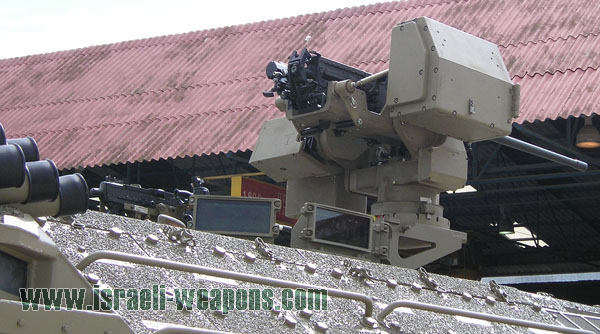
Cross-wind, Barometric, Geo-rotational Sensor

Anti-mine rollers and Dozer Blade

Internal Layout
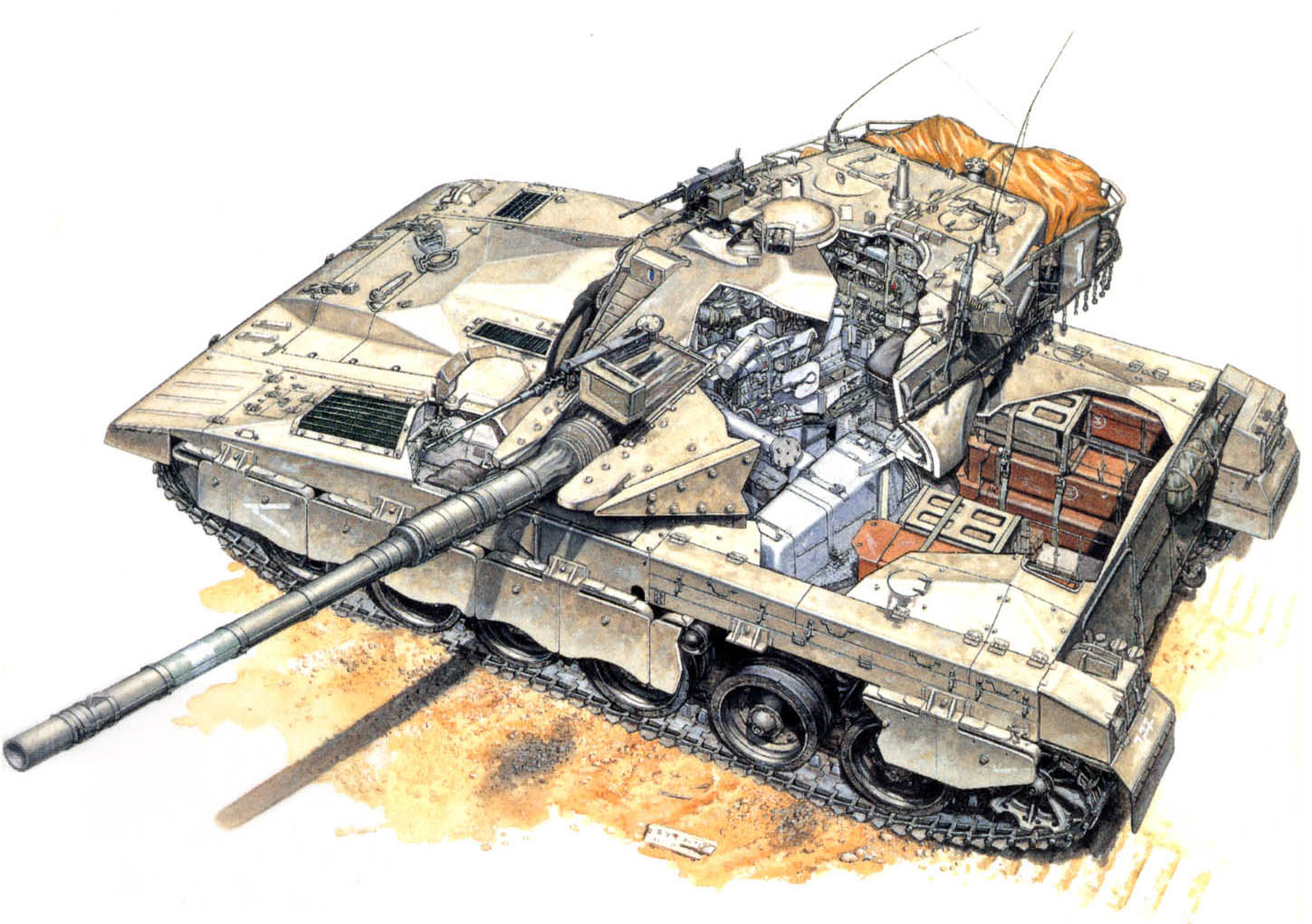
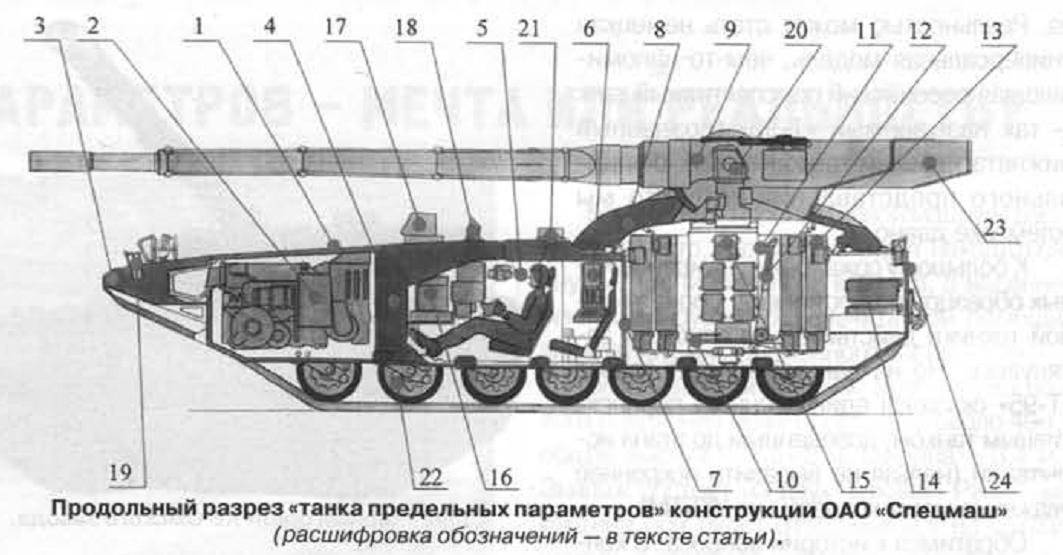
Driver's Station

Commander's Station (Behind Driver's Station)

Gunner's Station



Loader's Station (Next to Gunner's Station)


Commander's Station (Behind Driver's Station)

Gunner's Station
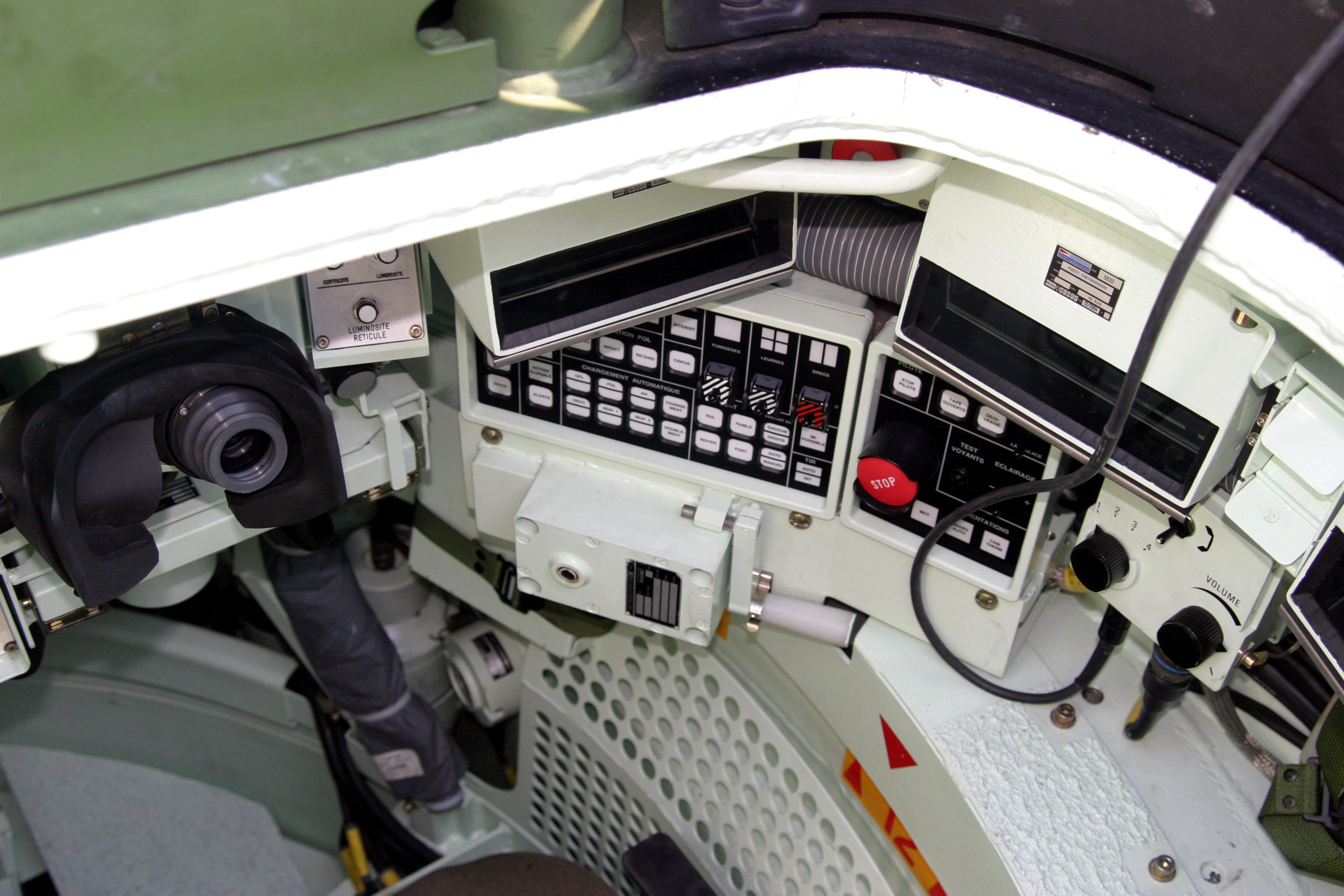
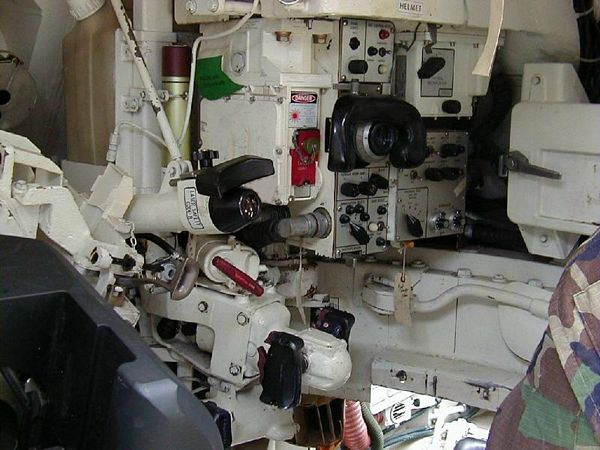

Loader's Station (Next to Gunner's Station)

Summary
Armor And Turret Assembly
Active Protection System
Secure Communicator
Ammunition Storage
Laser Designators
Tracked Propulsion System
Passive Signature Reduction and Environmental Protection
140mm main gun, ammunition, and loader
20mm coaxial autocannon and ammunition (Energy Enveloped w/ Charged Ions)
60mm internal mortar (gas grenades)
Overhead Weapon Station (Remote Operated)
Cross-wind, Barometric, Geo-rotational Sensor
Anti-mine rollers and Dozer Blade
- (+) Highly sloped armor reduces chance of critical hits from kinetic weapons, especially from front arc
- (+) Front slope of turret has the greatest 'effective' armor rating
- (+) Turret shape designed to provide protection from ground-based and air-based attacks
- (+) Bottom of vehicle shaped to protect against anti-tank mines
- (+) Armor protects occupants from radiation and chemical hazards while in vehicle
- (+) Beskar main cannon highly resilient to direct damage
- (+) Vehicle retains good weapon accuracy and standard tracking speeds while moving
- (+) Capable of engaging slower aircraft with Coaxial Autocannon
- (+/-) Sturdy turret-ring allows for multiple hits before becoming vulnerable, but will become vulnerable with repeated shots
- (--) Side and rear armor weakest against shots received from behind the vehicle
- (--) Bottom-rear of turret is vulnerable to anti-tank weapons
- (--) Slower turret traverse speed than most other tanks
- (--) Weight of main cannon makes manual turret rotation impossible
- (--) Gun-sights of main cannon vulnerable to damage while tank is under fire
Active Protection System
- (+) Capable of stopping guided and unguided missiles
- (+) Can also be used to try and stop or disrupt most mass-driver rounds
- (+/-) Can fire 32 times per side before requiring reloading
- (--) Stops missiles at close enough ranges that most area of effect warheads still effect the vehicle
- (--) Must be reloaded from outside the vehicle
Secure Communicator
- (+) Telephone is well protected against stray shots
- (--) Enemy infantry capable of verbally harassing trapped crew members
Ammunition Storage
- (+) Protects against fire or penetrating shots causing the explosive ammo to detonate
- (--) Slows down load times and can exhaust loader during intense combat
Laser Designators
- (+) Capable of painting a ground or air target for orbital bombardment or airstrike
- (+) Cannot be spotted by the naked eye
- (--) Does not work in low-visibility conditions
- (--) Highly vulnerable to damage when the tank is fired upon
Tracked Propulsion System
- (+) Highly resistant to direct damage or breaking
- (+) Good acceleration and deceleration, good turning speeds, good off-roading capabilities
- (+/-) Easy to repair, but extremely difficult to safely 'lift' tank to repair damaged tracks
- (--) While tracks are unlikely to break, direct hits can often break smaller components that hold the tracks together
- (--) Heavy weight of vehicle likely to cause it to become stuck in deep mud, sand, or snow.
Passive Signature Reduction and Environmental Protection
- (+) Designed to protect crew from hostile environments; be it a radiation, chemical, or biological hazard
- (+/-) Harder to passively spot on sensors, but no means is it immune to sensors
140mm main gun, ammunition, and loader
- (+) Fires Supersonic-Velocity Rounds
- (+) Round travels faster than the speed of sound
- (+) High kinetic damage output
- (+) Can pre-load ammunition revolver with different rounds
- (+) Gunner can 'skip' to a pre-loaded round for quick and precise use of variable ammunition options
- (+/-) Limited ammunition capacity
- (+/-) Can prepare 'revolver' with different ammunition for rapid selection of a needed round
- (+/-) High rate of fire, but difficult to reload quickly
- (--) Expensive Gun, Breach, and Mounting
- (--) Expensive ammunition
- (--) Cannot be manually operated when vehicle is disabled
20mm coaxial autocannon and ammunition (Energy Enveloped w/ Charged Ions)
- (+) Does double the damage of a standard 20mm Autocannon, thanks to energy envelopment
- (+) Highly effective against heavy infantry and light vehicles
- (+/-) Limited ammunition capacity
- (+/-) Can quickly deplete itself of ammunition
- (--) Not very effective against heavy vehicles
60mm internal mortar (gas grenades)
- (+) Capable of temporarily disrupting sensors over a large area
- (+/-) Limited duration and ammunition capacity
- (--) Must be reloaded externally
- (--) Does not work in high winds or storms
Overhead Weapon Station (Remote Operated)
- (+) Can be remotely operated, allowing crew to stay within the protection of the vehicle
- (+) Can rotate to fire in 360-degrees around vehicle
- (+/-) Limited ammunition that must be reloaded externally
- (--) Limited view from weapon's camera system
- (--) Motorizes system vulnerable to damage when tank is being fired upon
- (--) Cameras, sensor, and operating equipment highly vulnerable to damage when tank is being fired upon
Cross-wind, Barometric, Geo-rotational Sensor
- (+) Helps increase weapon accuracy at extreme ranges
- (--) Highly vulnerable to damage when tank is being fired upon
Anti-mine rollers and Dozer Blade
- (+) Capable of safely triggering anti-tank and anti-personnel mines.
- (+/-) Heavy and time consuming to install in the field
- (--) Does not work against remotely detonated mines
- (--) Typically slows down equipped vehicle by 5km and makes it less maneuverable
- (--) Can restrict equipped vehicle's movements in urban settings
Variants
Command and Control Vehicle
 Myrkr-class Armored Vehicle - Assault/Command "Myrkava-C"
Myrkr-class Armored Vehicle - Assault/Command "Myrkava-C"
The Myrkr CCV supports an additional two crewmen. A sensor operator and a battalion commander responsible for coordinating an entire ground fighting force. Though the vehicle still retains space for two passengers, this room is typically reserved for individuals critical to the coordination of other fighting units on the battlefield. Supporting these crewmembers is a host of additional equipment. An advanced Communications tower dons the back-left portion of the turret and the vehicle lacks a pintle mounted .32cal Automatic Weapon. Mounted internally are additional sensors, targeting systems, battle computers, IFF transcievers, and other equipment suited to coordinating a battlefield comprised of tanks, personnel carriers, armored infantry, and other advanced military hardware.
Tankbulance
 Myrkr-class Armored Vehicle - Assault/Medical "Myrkava-M"
Myrkr-class Armored Vehicle - Assault/Medical "Myrkava-M"
Some Myrkr-class tanks have been fitted with full medical and ambulance capabilities while retaining their armament (but carrying less ammunition than the standard tank). The cabin area has been converted for carrying injured personnel and has had two stretchers and life support medical stations systems added with a three man medical team complement to operate under combat conditions with a tank battalion.
Urban Combat Vehicle
Myrkr-class Armored Vehicle - Assault/Urban "Myrkava-U"
The Myrkr LIC “Low Intensity Conflict” Vehicle is designed to operate in the cramped confines of the urban combat environment. To achieve this, the overall length of the main barrel has been replaced by a snub version that is 1.5 meters shorter. This greatly reduces the long range accuracy and maximum effective range of the weapon, but enables the turret and vehicle to operate in cramped city streets and back alleys. A larger and more expensive motor is used to turn the turret of the Myrkava-U variant. With the improved motor and the shorter and much lighter turret, The Myrkava-U's turret boasts a significantly quicker turret traverse speed. Similarly, improvements are made to the drive and suspension that provide the Myrkava-U's chassis with a superior traverse speed. The most sensitive areas of the tank; its optics, exhaust ports, and ventilators are all protected by high-strength beskar armorweave-mesh that prevents the possibility of explosive charges being planted over these areas. Rubber whip pole-markers with LED tips and a driver's rear-facing camera are installed to provide improved navigation and maneuverability in urban environments by day or by night. (Merkava) Instead of the typical 30 fireproof canisters for explosive ammo storage, the Myrkava-U holds a full 60 canisters. Intended to operate at close ranges, the vehicle has no use for discarding sabot ammunition and instead carries 10x AP, 10x HE, 10x HE-FRAG, 10x HEAT, 10x HESH, and 10x Incendiary rounds.
Armored Personnel Carrier

 Myrkr-class Armored Vehicle - Exfiltration "Myrkave" ('Mer-kav-eh')
Myrkr-class Armored Vehicle - Exfiltration "Myrkave" ('Mer-kav-eh')
Myrkr-class Armored Vehicle - Exfiltration/Medical "Myrkave-M"
The Myrkr-class Armored Personnel Vehicle is a lighter, faster variant of the core model that forgoes a turret and primary weapon to acquire advanced crew capacity. The core of the Myrkr's design is worked into the sloped hull of the vehicle even after the removal of the turret. For weaponry, the Myrkr-class APC mounts the Remote Operated Pintol 40mm Grenade Launcher, .52cal Automatic Weapon, and .32cal Automatic Weapon. The vehicle only requires three crewmen and is capable of safely transporting 12 fully armored Mandalorian Soldiers to and from the battlefield, or can carry 10 soldiers and a stretcher. An ambulance variant of the APC is capable of carrying four casualties on stretchers as well as life support medical stations and a four man medical team complement to operate under combat conditions. The vehicle is capable of speeds of 75 KM/H on road and 65 KM/H off road.
Armored Recovery Vehicle
 Myrkr-class Armored Vehicle - Utility "Myrkavu" ('Mer-kav-oo')
Myrkr-class Armored Vehicle - Utility "Myrkavu" ('Mer-kav-oo')
Based on the Myrkr-class Armored Personnel Carrier chassis, the Myrkr ARV is equipped with a 60 ton-meter crane and a 45 ton-meter winch. The vehicle is capable of towing disabled tanks and carries a complete Myrkr back-up power pack that can be changed in the field in under 90 minutes. It will often deploy dragging a tracked trailer fully loaded replacement tracks, wheels, turret rings, and other critical components for fast and easy replacement in the field. The vehicle is capable of speeds of 75 KM/H on road and 65 KM/H off road.
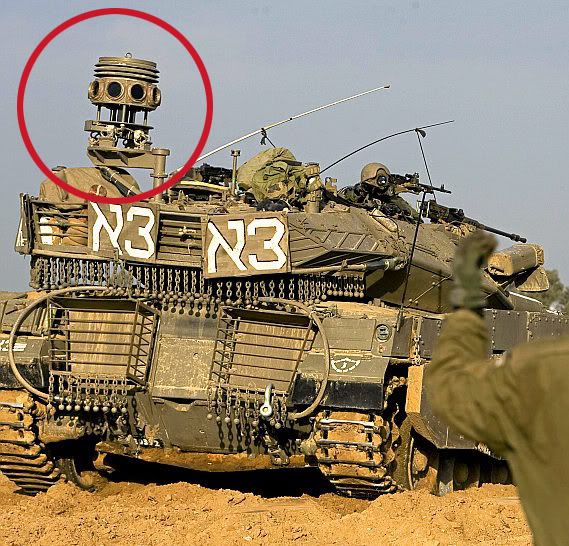
The Myrkr CCV supports an additional two crewmen. A sensor operator and a battalion commander responsible for coordinating an entire ground fighting force. Though the vehicle still retains space for two passengers, this room is typically reserved for individuals critical to the coordination of other fighting units on the battlefield. Supporting these crewmembers is a host of additional equipment. An advanced Communications tower dons the back-left portion of the turret and the vehicle lacks a pintle mounted .32cal Automatic Weapon. Mounted internally are additional sensors, targeting systems, battle computers, IFF transcievers, and other equipment suited to coordinating a battlefield comprised of tanks, personnel carriers, armored infantry, and other advanced military hardware.
Tankbulance
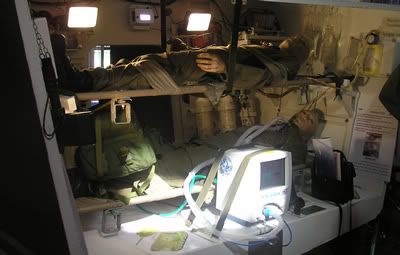
Some Myrkr-class tanks have been fitted with full medical and ambulance capabilities while retaining their armament (but carrying less ammunition than the standard tank). The cabin area has been converted for carrying injured personnel and has had two stretchers and life support medical stations systems added with a three man medical team complement to operate under combat conditions with a tank battalion.
Urban Combat Vehicle
Myrkr-class Armored Vehicle - Assault/Urban "Myrkava-U"
The Myrkr LIC “Low Intensity Conflict” Vehicle is designed to operate in the cramped confines of the urban combat environment. To achieve this, the overall length of the main barrel has been replaced by a snub version that is 1.5 meters shorter. This greatly reduces the long range accuracy and maximum effective range of the weapon, but enables the turret and vehicle to operate in cramped city streets and back alleys. A larger and more expensive motor is used to turn the turret of the Myrkava-U variant. With the improved motor and the shorter and much lighter turret, The Myrkava-U's turret boasts a significantly quicker turret traverse speed. Similarly, improvements are made to the drive and suspension that provide the Myrkava-U's chassis with a superior traverse speed. The most sensitive areas of the tank; its optics, exhaust ports, and ventilators are all protected by high-strength beskar armorweave-mesh that prevents the possibility of explosive charges being planted over these areas. Rubber whip pole-markers with LED tips and a driver's rear-facing camera are installed to provide improved navigation and maneuverability in urban environments by day or by night. (Merkava) Instead of the typical 30 fireproof canisters for explosive ammo storage, the Myrkava-U holds a full 60 canisters. Intended to operate at close ranges, the vehicle has no use for discarding sabot ammunition and instead carries 10x AP, 10x HE, 10x HE-FRAG, 10x HEAT, 10x HESH, and 10x Incendiary rounds.
Armored Personnel Carrier
.jpg)
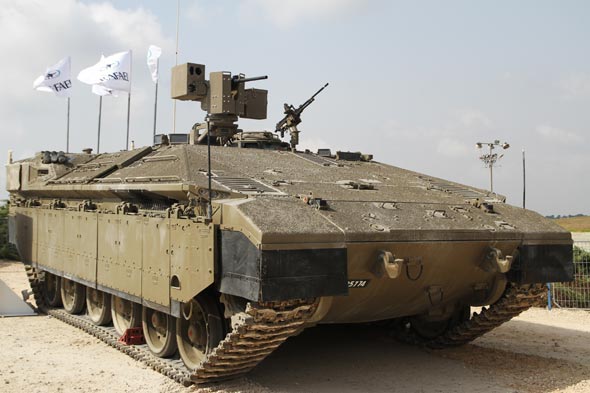
Myrkr-class Armored Vehicle - Exfiltration/Medical "Myrkave-M"
The Myrkr-class Armored Personnel Vehicle is a lighter, faster variant of the core model that forgoes a turret and primary weapon to acquire advanced crew capacity. The core of the Myrkr's design is worked into the sloped hull of the vehicle even after the removal of the turret. For weaponry, the Myrkr-class APC mounts the Remote Operated Pintol 40mm Grenade Launcher, .52cal Automatic Weapon, and .32cal Automatic Weapon. The vehicle only requires three crewmen and is capable of safely transporting 12 fully armored Mandalorian Soldiers to and from the battlefield, or can carry 10 soldiers and a stretcher. An ambulance variant of the APC is capable of carrying four casualties on stretchers as well as life support medical stations and a four man medical team complement to operate under combat conditions. The vehicle is capable of speeds of 75 KM/H on road and 65 KM/H off road.
Armored Recovery Vehicle
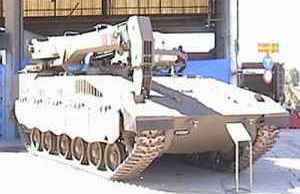
Based on the Myrkr-class Armored Personnel Carrier chassis, the Myrkr ARV is equipped with a 60 ton-meter crane and a 45 ton-meter winch. The vehicle is capable of towing disabled tanks and carries a complete Myrkr back-up power pack that can be changed in the field in under 90 minutes. It will often deploy dragging a tracked trailer fully loaded replacement tracks, wheels, turret rings, and other critical components for fast and easy replacement in the field. The vehicle is capable of speeds of 75 KM/H on road and 65 KM/H off road.





